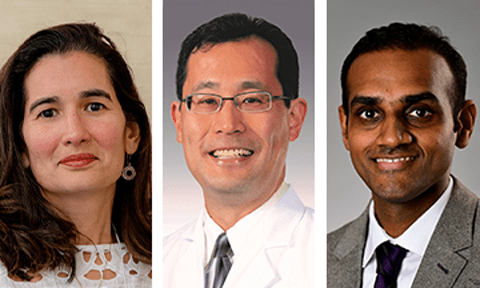
In the spring of 2024, members of the Public Education & Awareness Committee (PEAC) hosted a webinar to share the information that genetic technology results can provide clinicians and researchers. Speakers used anonymized clinical reports to address the range of results. A number of questions remained at the end of the hour-long presentation and Question and Answer session. Speakers and PEAC members Arvind Kothandaraman, MBS, PEAC Chair Joseph Shen, MD, PhD, and Nara Sobreira, MD, PhD shared their responses to these remaining questions. Access the full webinar recording on-demand on the ASHG Learning Center.
- How can penetrance and expression of the causative gene or variant be detected if a submitter requests this information? Should it be included in the final report?
JS: This level of information is difficult for the performing laboratory to integrate into the genetic testing report, even if asked for by the ordering physician/clinical team. The performing laboratory mainly concentrates on bioinformatic and published data. Generally, the lab report serves as a starting point for the submitter to perform their own literature search, contact research teams, etc., and determine the possible significance in relation to the individual that they are clinically taking care of.NS: Most of the reports include a summary of the gene and the diseases caused by pathogenic variants in the gene reported. If incomplete penetrance or variable expressivity of the phenotype are well-known characteristics, they will be mentioned in the report. But as mentioned by Dr. Shen the report is a summary. The clinician needs to investigate further about the variant, gene, and phenotype before discussing the results with the patient.
- What limitations do buccal swabs have in relation to gestational age or day of life?
JS:
Generally, it is not thought that there are limitations to sample collection of buccal cells, which naturally and constantly are coming off the inside surfaces of the mouth.
NS: I agree with Dr. Shen. I do not know of any limitation related to the use of buccal swabs in specific gestational age or day of life.
- How can we tackle the issue of doctors avoiding the use of genetic diagnostic tests when they learn about Variant of Uncertain Significance (VUS), even if they know this means a longer diagnosis journey for their patients?
JS: Speaking from a clinical geneticist point of view, this is why pre-test genetic counseling is so important. I would rather that there is hesitation to order genetic tests because of the possibility (actually probably more likely than not) of VUSs, than the mindset of ordering tests without taking into account the possibility of receiving something other than a positive or negative result. A VUS is classified this way because there is not enough bioinformatic data, but to the ordering clinical team, this may indeed be the molecular diagnosis. This is because the team can draw clinical conclusions by integrating the patient’s medical information with knowledge from published articles.NS: Education is the key word here. Clinical geneticists and non-clinical geneticists need to know that the rate of VUSs with exomes is low. Even when reported these variants can help to define the clinical diagnosis.
- Do you have the option to opt out from VUSs if the patient chooses?
JS: Generally, there is not the option to opt out of VUSs, because the reported variant could be clinically useful and relevant. In prenatal genetic testing, however, the criteria for reporting can be different, as the purpose of testing in these circumstances is more to uncover “yes” or “no” type of information and results.NS: As long as I know, no, one cannot opt out of VUSs.
- When do you anticipate genome sequencing will replace exome sequencing?
AK: Genome sequencing may never completely replace exome sequencing in the next several decades – polymerase chain reaction (PCR) is a reasonably close precedent that tells us how long such technology transitions can take. There are several factors that favor the continued use and adoption of a targeted approach versus whole genome sequencing. Notable among them are sequencing cost, informatics cost (analysis, interpretation, and storage), turnaround time and increase in complexity and ambiguity of clinical results. In research applications, the shift in sentiment favoring a complete displacement of whole exome sequencing by whole genome sequencing may be more imminent – potentially over the next 1-2 decades – due to inherent advantages pertinent to research (e.g., richer datasets) and advancements in technology (e.g., long reads, lower cost).
- In a situation where an educated guess could be made as to which genes are likely affected, what is the threshold to order an exome sequence as opposed to a gene panel?
JS: This is a complicated question and dependent on factors such as ordering team’s preferences, insurance logistics, willingness to add on potential genetic information not directly linked to the reason for performing genetic testing (secondary findings, pharmacogenetic results, etc.), turnaround time, availability of parents and other family members, among other considerations. It is also recognized that there can be differences in gene coverage and types of variants that can be detected, technical nuances of the molecular platforms being used, and individual laboratory filtering pipeline differences. Having said all of this, typically if well-characterized phenotype that is amenable to a next generation sequencing panel, this is what is ordered first. Then can consider exome/genome.
Arvind Kothandaraman, MBS is the General Manager of Multiomics and Specialty Diagnostics at Revvity (formerly PerkinElmer).
Joseph Shen, MD, PhD is an Associate Professor in the Division of Genomic Medicine in the Department of Pediatrics at University of California, Davis.
Nara Sobreira, MD, PhD is an Associate Professor at the McKusick-Nathans Department of Genetic Medicine at Johns Hopkins University School of Medicine
